1. 概述
(1) Completely Fair Scheduler,完全公平调度器,用于 Linux 系统中普通进程的调度。
(2) CFS 采用了红黑树算法来管理所有的调度实体 sched_entity,算法效率为 O(log(n))。CFS 跟踪调度实体 sched_entity 的虚拟运行时间 vruntime,平等对待运行队列中的调度实体 sched_entity,将执行时间少的调度实体 sched_entity 排列到红黑树的左边。
(3) 调度实体 sched_entity 通过 enqueue_entity()和 dequeue_entity()来进行红黑树的出队入队。
文章推荐视频:
C/C++Linux 后台服务器开发高级架构师免费学习链接:C/C++Linux服务器开发高级架构师/Linux后台架构师-学习视频
进程调度器的实现,完全公平调度器 CFS
Linux内核 进程管理,调度器的5种实现
老规矩,先上张图片来直观了解一下原理:
(1) 每个 sched_latency 周期内,根据各个任务的权重值,可以计算出运行时间 runtime;(2) 运行时间 runtime 可以转换成虚拟运行时间 vruntime;(3) 根据虚拟运行时间的大小,插入到 CFS 红黑树中,虚拟运行时间少的调度实体放置到左边;(4) 在下一次任务调度的时候,选择虚拟运行时间少的调度实体来运行;
2. 数据结构
2.1 调度类 Linux 内核抽象了一个调度类 struct sched_class,这是一种典型的面向对象的设计思想,将共性的特征抽象出来封装成类,在实例化各个调度器的时候,可以根据具体的调度算法来实现。这种方式做到了高内聚低耦合,同时又很容易扩展新的调度器。
在调度核心代码 kernel/sched/core.c 中,使用的方式是 task->sched_class->xxx_func, 其中 task 表示的是描述任务的结构体 struct task_struct,在该结构体中包含了任务所使用的调度器,进而能找到对应的函数指针来完成调用执行,有点类似于 C++中的多态机制。
2.2 rq/cfs_rq/task_struct/task_group/sched_entity
(1) struct rq:每个 CPU 都有一个对应的运行队列;
(2) struct cfs_rq:CFS 运行队列,该结构中包含了 struct rb_root_cached 红黑树,用于链接调度实体 struct sched_entity。rq 运行队列中对应了一个 CFS 运行队列,此外,在 task_group 结构中也会为每个 CPU 再维护一个 CFS 运行队列;
(3) struct task_struct:任务的描述符,包含了进程的所有信息,该结构中的 struct sched_entity,用于参与 CFS 的调度;
(4) struct task_group:组调度(参考前文),Linux 支持将任务分组来对 CPU 资源进行分配管理,该结构中为系统中的每个 CPU 都分配了 struct sched_entity 调度实体和 struct cfs_rq 运行队列,其中 struct sched_entity 用于参与 CFS 的调度;
(5) struct sched_entity:调度实体,这个也是 CFS 调度管理的对象了;
C/C++Linux 后台服务器开发高级架构师学习视频 点击 linux服务器学习资料 获取,内容知识点包括 Linux,Nginx,ZeroMQ,MySQL,Redis,线程池,MongoDB,ZK,Linux 内核,CDN,P2P,epoll,Docker,TCP/IP,协程,DPDK 等等。免费学习链接:C/C++Linux服务器开发高级架构师/Linux后台架构师-学习视频
来一张图看看它们之间的组织关系:
(1) struct sched_entity 结构体字段注释如下:
/* CFS-related fields in a runqueue */struct cfs_rq { struct load_weight load; //CFS运行队列的负载权重值 unsigned int nr_running, h_nr_running; //nr_running:运行的调度实体数(参与时间片计算)
u64 exec_clock; //运行时间 u64 min_vruntime; //最少的虚拟运行时间,调度实体入队出队时需要进行增减处理#ifndef CONFIG_64BIT u64 min_vruntime_copy;#endif
struct rb_root_cached tasks_timeline; //红黑树,用于存放调度实体
/* * 'curr' points to currently running entity on this cfs_rq. * It is set to NULL otherwise (i.e when none are currently running). */ struct sched_entity *curr, *next, *last, *skip; //分别指向当前运行的调度实体、下一个调度的调度实体、CFS运行队列中排最后的调度实体、跳过运行的调度实体
#ifdef CONFIG_SCHED_DEBUG unsigned int nr_spread_over;#endif
#ifdef CONFIG_SMP /* * CFS load tracking */ struct sched_avg avg; //计算负载相关 u64 runnable_load_sum; unsigned long runnable_load_avg; //基于PELT的可运行平均负载#ifdef CONFIG_FAIR_GROUP_SCHED unsigned long tg_load_avg_contrib; //任务组的负载贡献 unsigned long propagate_avg;#endif atomic_long_t removed_load_avg, removed_util_avg;#ifndef CONFIG_64BIT u64 load_last_update_time_copy;#endif
#ifdef CONFIG_FAIR_GROUP_SCHED /* * h_load = weight * f(tg) * * Where f(tg) is the recursive weight fraction assigned to this group. */ unsigned long h_load; u64 last_h_load_update; struct sched_entity *h_load_next;#endif /* CONFIG_FAIR_GROUP_SCHED */#endif /* CONFIG_SMP */
#ifdef CONFIG_FAIR_GROUP_SCHED struct rq *rq; /* cpu runqueue to which this cfs_rq is attached */ //指向CFS运行队列所属的CPU RQ运行队列
/* * leaf cfs_rqs are those that hold tasks (lowest schedulable entity in * a hierarchy). Non-leaf lrqs hold other higher schedulable entities * (like users, containers etc.) * * leaf_cfs_rq_list ties together list of leaf cfs_rq's in a cpu. This * list is used during load balance. */ int on_list; struct list_head leaf_cfs_rq_list; struct task_group *tg; /* group that "owns" this runqueue */ //CFS运行队列所属的任务组
#ifdef CONFIG_CFS_BANDWIDTH int runtime_enabled; //CFS运行队列中使用CFS带宽控制 u64 runtime_expires; //到期的运行时间 s64 runtime_remaining; //剩余的运行时间
u64 throttled_clock, throttled_clock_task; //限流时间相关 u64 throttled_clock_task_time; int throttled, throttle_count; //throttled:限流,throttle_count:CFS运行队列限流次数 struct list_head throttled_list; //运行队列限流链表节点,用于添加到cfs_bandwidth结构中的cfttle_cfs_rq链表中#endif /* CONFIG_CFS_BANDWIDTH */#endif /* CONFIG_FAIR_GROUP_SCHED */};
复制代码
3. 流程分析
整个流程分析,围绕着 CFS 调度类实体:fair_sched_class 中的关键函数来展开。
先来看看 fair_sched_class 都包含了哪些函数:
/* All the scheduling class methods: */const struct sched_class fair_sched_class = { .next = &idle_sched_class, .enqueue_task = enqueue_task_fair, .dequeue_task = dequeue_task_fair, .yield_task = yield_task_fair, .yield_to_task = yield_to_task_fair,
.check_preempt_curr = check_preempt_wakeup,
.pick_next_task = pick_next_task_fair, .put_prev_task = put_prev_task_fair,
#ifdef CONFIG_SMP .select_task_rq = select_task_rq_fair, .migrate_task_rq = migrate_task_rq_fair,
.rq_online = rq_online_fair, .rq_offline = rq_offline_fair,
.task_dead = task_dead_fair, .set_cpus_allowed = set_cpus_allowed_common, #endif
.set_curr_task = set_curr_task_fair, .task_tick = task_tick_fair, .task_fork = task_fork_fair,
.prio_changed = prio_changed_fair, .switched_from = switched_from_fair, .switched_to = switched_to_fair,
.get_rr_interval = get_rr_interval_fair,
.update_curr = update_curr_fair,
#ifdef CONFIG_FAIR_GROUP_SCHED .task_change_group = task_change_group_fair, #endif};
复制代码
3.1 runtime 与 vruntime
CFS 调度器没有时间片的概念了,而是根据实际的运行时间和虚拟运行时间来对任务进行排序,从而选择调度。那么,运行时间和虚拟运行时间是怎么计算的呢?看一下流程调用:
(1) Linux 内核默认的 sysctl_sched_latency 是 6ms,这个值用户态可设。sched_period 用于保证可运行任务都能至少运行一次的时间间隔;(2) 当可运行任务大于 8 个的时候,sched_period 的计算则需要根据任务个数乘以最小调度颗粒值,这个值系统默认为 0.75ms;(3) 每个任务的运行时间计算,是用 sched_period 值,去乘以该任务在整个 CFS 运行队列中的权重占比;(4) 虚拟运行的时间 = 实际运行时间 * NICE_0_LOAD / 该任务的权重;
从上面计算公式可以看出,权重高的进程运行时间 runtime 更大,但是 vruntime 由于分子分母互相消除,权重高的进程的虚拟运行时间的增速却是一样的。
还是来看一个实例吧,以 5 个 Task 为例,其中每个 Task 的 nice 值不一样(优先级不同),对应到的权重值在内核中提供了一个转换数组:
/*权重只和进程的nice值有关*/const int sched_prio_to_weight[40] = { /* -20 */ 88761, 71755, 56483, 46273, 36291, /* -15 */ 29154, 23254, 18705, 14949, 11916, /* -10 */ 9548, 7620, 6100, 4904, 3906, /* -5 */ 3121, 2501, 1991, 1586, 1277, /* 0 */ 1024, 820, 655, 526, 423, /* 5 */ 335, 272, 215, 172, 137, /* 10 */ 110, 87, 70, 56, 45, /* 15 */ 36, 29, 23, 18, 15,};
复制代码
从 sched_prio_to_weight[]可知,nice 值每减小 1,权重增加约 25%,一个调度周期中大约可以多获得 25%的 CPU 时间。
C/C++Linux 后台服务器开发高级架构师学习视频 点击 linux服务器学习资料 获取,内容知识点包括 Linux,Nginx,ZeroMQ,MySQL,Redis,线程池,MongoDB,ZK,Linux 内核,CDN,P2P,epoll,Docker,TCP/IP,协程,DPDK 等等。免费学习链接:C/C++Linux服务器开发高级架构师/Linux后台架构师-学习视频
图来了:
3.2 CFS 调度 tick
CFS 调度器中的 tick 函数为 task_tick_fair,系统中每个调度 tick 都会调用到,此外如果使用了 hrtimer,也会调用到这个函数。流程如下:
主要的工作包括:
从 sched_prio_to_weight[]可知,nice 值每减小 1,权重增加约 25%,一个调度周期中大约可以多获得 25%的 CPU 时间。
C/C++Linux 后台服务器开发高级架构师学习视频 点击 linux服务器学习资料 获取,内容知识点包括 Linux,Nginx,ZeroMQ,MySQL,Redis,线程池,MongoDB,ZK,Linux 内核,CDN,P2P,epoll,Docker,TCP/IP,协程,DPDK 等等。免费学习链接:C/C++Linux服务器开发高级架构师/Linux后台架构师-学习视频
图来了:
3.2 CFS 调度 tick
CFS 调度器中的 tick 函数为 task_tick_fair,系统中每个调度 tick 都会调用到,此外如果使用了 hrtimer,也会调用到这个函数。流程如下:
主要的工作包括:
(1) 更新运行时的各类统计信息,比如 vruntime, 运行时间、负载值、权重值等;
(2) 检查是否需要抢占,主要是比较运行时间是否耗尽,以及 vruntime 的差值是否大于运行时间等;
来一张图,感受一下 update_curr 函数的相关信息更新吧:
/*注册这些定时器中断*/arch_timer_register(void) //drivers\clocksource\arm_arch_timer.c irqreturn_t timer_handler(const int access, struct clock_event_device *evt) //drivers\clocksource\arm_arch_timer.c evt->event_handler(evt); tick_device_uses_broadcast(struct clock_event_device *dev, int cpu) //kernel\time\tick-broadcast.c tick_handle_periodic(struct clock_event_device *dev) //kernel\time\tick-common.c tick_periodic(int cpu) //kernel\time\tick-common.c /*在定时器中断处理函数中调用,user_tick若是用户时间为1,若是系统时间为0*/ update_process_times(int user_tick) //kernel\time\timer.c /*这个函数是在定时器的代码中被调用,调用周期为HZ,关着中断调用的*/ scheduler_tick(void) //kernel\sched\core.c
/*切换到高分辨率模式*/hrtimer_switch_to_hres(void) tick_setup_sched_timer(void) //kernel\time\tick-sched.c tick_sched_timer(struct hrtimer *timer) //kernel\time\tick-sched.c tick_sched_handle(struct tick_sched *ts, struct pt_regs *regs) //kernel\time\tick-sched.c update_process_times(user_mode(regs));
tick_nohz_switch_to_nohz(void) /*nohz低分辨率中断处理函数*/ tick_nohz_handler(struct clock_event_device *dev) tick_sched_handle(struct tick_sched *ts, struct pt_regs *regs) //kernel\time\tick-sched.c update_process_times(user_mode(regs));
复制代码
3.3 任务出队入队
(1) 当任务进入可运行状态时,需要将调度实体放入到红黑树中,完成入队操作;(2) 当任务退出可运行状态时,需要将调度实体从红黑树中移除,完成出队操作(移除后放在哪?);(3) CFS 调度器,使用 enqueue_task_fair 函数将任务入队到 CFS 队列,使用 dequeue_task_fair 函数将任务从 CFS 队列中出队操作。
(1) 出队与入队的操作中,核心的逻辑可以分成两部分:
1)更新运行时的数据,比如负载、权重、组调度的占比等等;
2)将 sched_entity 插入红黑树,或者从红黑树移除;
(2) 由于 dequeue_task_fair 大体的逻辑类似,不再深入分析;
(3) 这个过程中,涉及到了 CPU 负载计算、task_group 组调度、CFS Bandwidth 带宽控制等,这些都在前边的文章中分析过,可以结合进行理解;
3.3 任务创建
在父进程通过 fork 创建子进程的时候,task_fork_fair 函数会被调用,这个函数的传入参数是子进程的 task_struct。该函数的主要作用,就是确定子任务的 vruntime,因此也能确定子任务的调度实体在红黑树 RB 中的位置。
task_fork_fair 本身比较简单,流程如下图:
3.4 任务选择
每当进程任务切换的时候,也就是 schedule 函数执行时,调度器都需要选择下一个将要执行的任务。在 CFS 调度器中,是通过 pick_next_task_fair 函数完成的,流程如下:
(1) 当需要进程任务切换的时候,pick_next_task_fair 函数的传入参数中包含了需要被切换出去的任务,也就是 pre_task;
(2) 当 pre_task 不是普通进程时,也就是调度类不是 CFS,那么它就不使用 sched_entity 的调度实体来参与调度,因此会执行 simple 分支,通过 put_pre_task 函数来通知系统当前的任务需要被切换,而不是通过 put_prev_entity 函数来完成;
(3) 当 pre_task 是普通进程时,调用 pick_next_entity 来选择下一个执行的任务,这个选择过程实际是有两种情况:当调度实体对应 task 时,do while()遍历一次,当调度实体对应 task_group 时,则需要遍历任务组来选择下一个执行的任务了。
(4) put_prev_entity,用于切换任务前的准备工作,更新运行时的统计数据,并不进行 dequeue 的操作,其中需要将 CFS 队列的 curr 指针置位成 NULL;
(5) set_next_entity,用于设置下一个要运行的调度实体,设置 CFS 队列的 curr 指针;
(6) 如果使能了 hrtimer,则将 hrtimer 的到期时间设置为调度实体的剩余运行时间;
(7) 调度类的优先级体现在 pick_next_task 函数中。
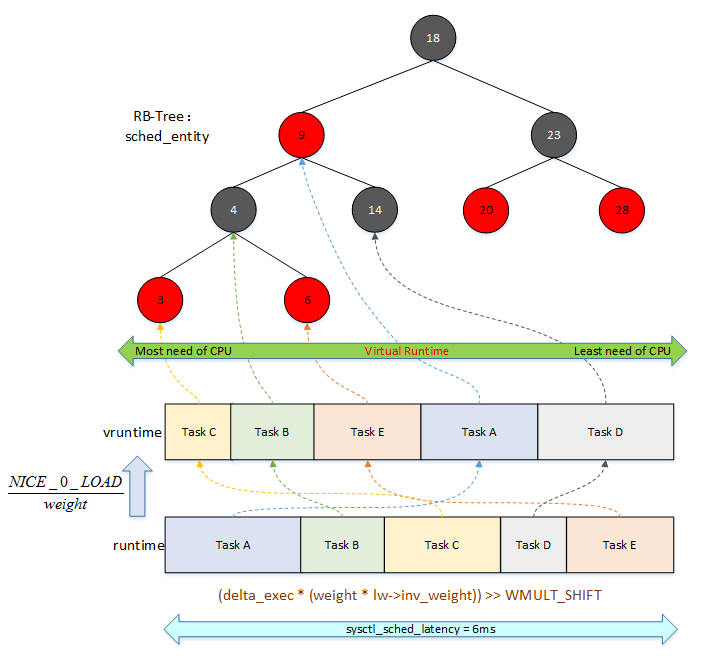
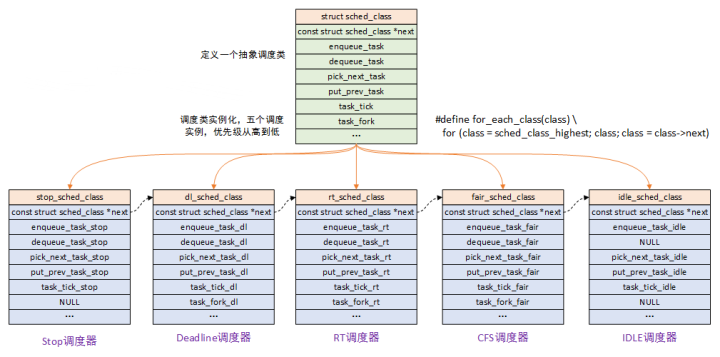
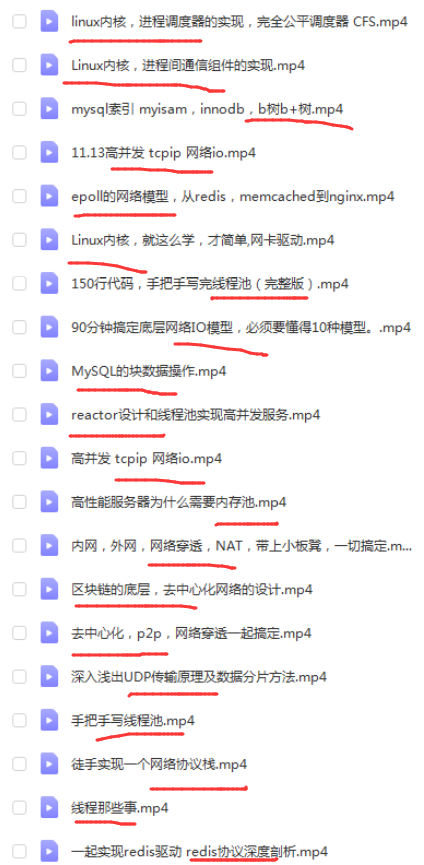
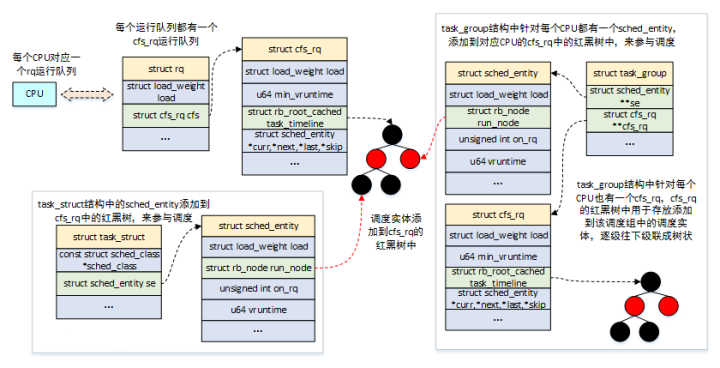
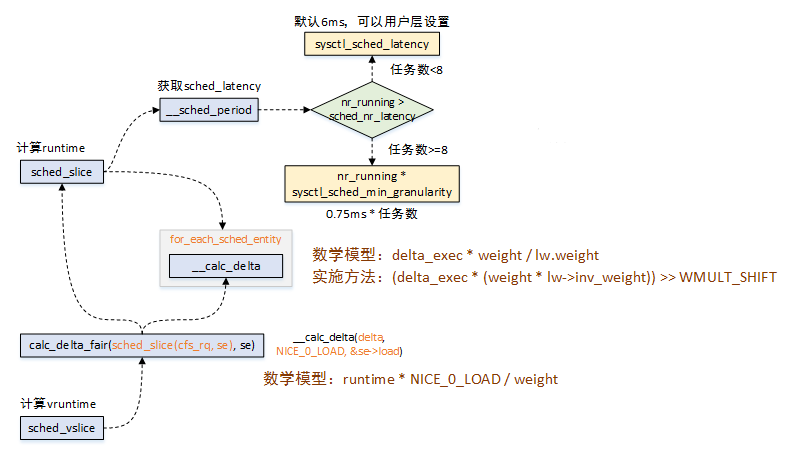

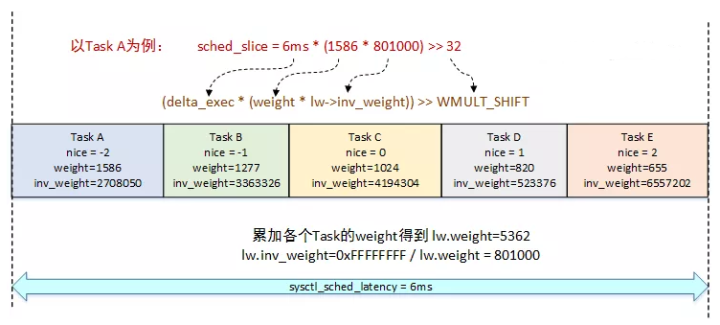
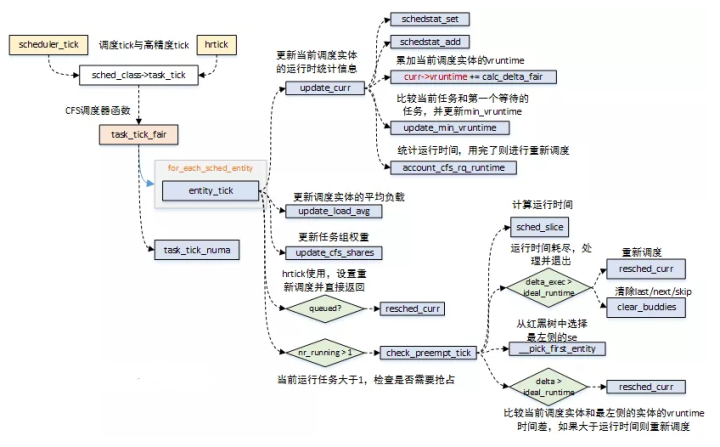

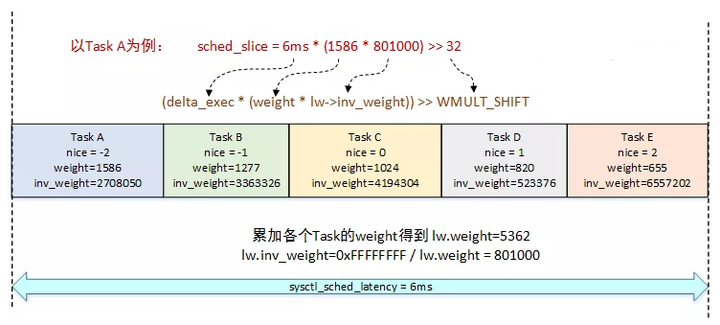

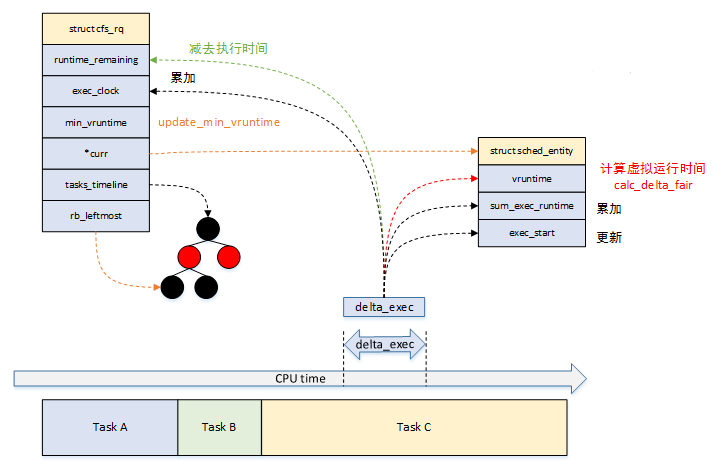
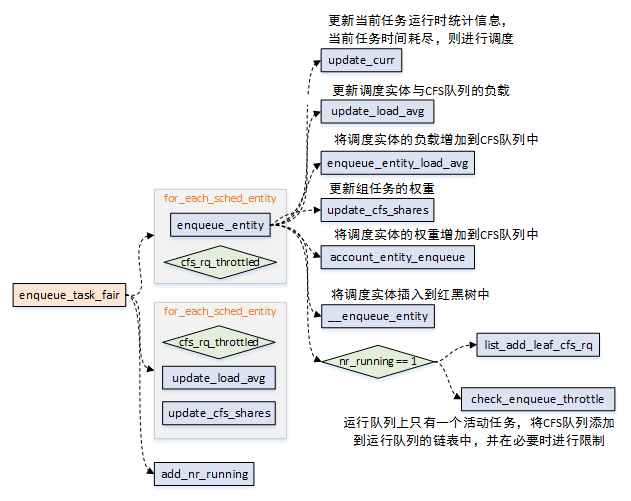
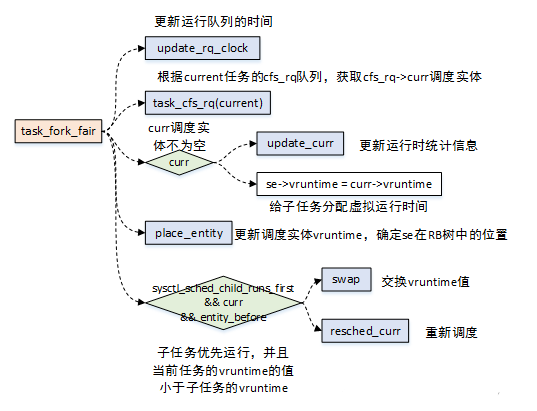
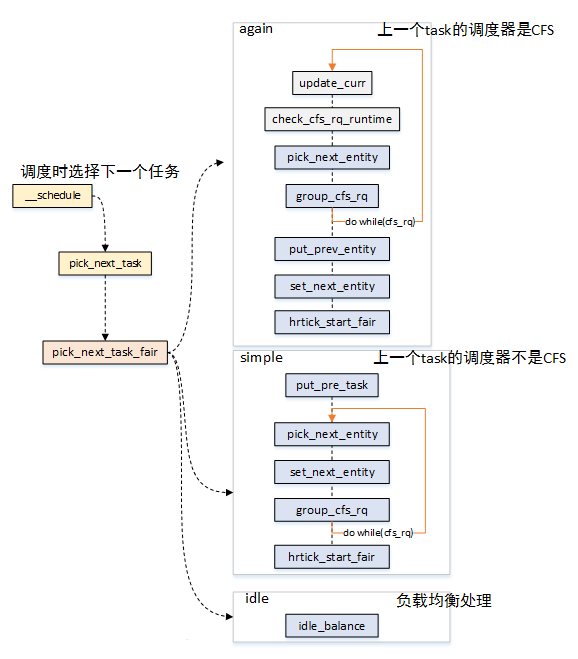












评论